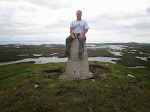Desert Wheatear – Barn Elms Reservoirs, London, 13th April 1989
Having started work with ERL (now ERM) in London in early 1989, I lived for two or three weeks with Gary and Debbie Hitchen at their home in Normandy Road, St. Albans, before finding my own accommodation, a room I rented from Sue Clacher at 11 Lower Dagnall Street, St. Albans.On the evening of Wednesday, the 13th April, whilst recuperating at ‘home’ after a hard day at work in Central London (involving commuting between St. Albans and Baker Street and Baker Street and St. Albans each day) I received a ‘phone call from Paul Pugh. The gist of his call was that there was, “A Desert Wheatear just down the road from you”. Now, I argued with him that description of ‘just down the road’ did not really apply to to Barn Elms Reservoirs (now the Wildfowl and Wetlands Trust’s London Wetlands Centre) in west, central London and on the south side of the Thames, given I was outside the M25, well to the north of London.... .
However, although it was well gone 18:00 and a long way to go, in my decrepit Ford Capri, as, especially after a long day’s work, I was grateful for the news. I was though, thrown into a quandary by the dilemma that faced me, or that I was faced with...... .
All the same, I decided to go for it. Driven by nervous tension / exhilaration and / or an idiot, more by luck than judgement than anything else, I made it; I successfully navigated there completely by instinct. I also successfully parked wherever I could and then rushed to the scene whilst there was still some light.
In doing so I got good views of my quest. My abiding memory was just how this stunning looking first summer male Desert Wheatear had somehow managed to find desert in Central London; it was feeding on the disused sand and gravel filter beds adjoining the reservoirs!! Nature is just incredible.
It was a real goodie. It had a solid black tail and white rump, and the black face mask which almost connected with the black of the primaries, secondaries and coverts, and otherwise the plumage was a very pale sandy brown.
Early(?) the following evening Paul descended from Wigan having twitched / before going to twitch the Desert Wheatear, complete with a car full comprising a very young Billy Aspin, Tony Disley and Dave Broome. When they arrived at the front door of Sue’s house Paul introduced Billy and Tony as being from Blackburn, and I couldn’t resist saying in my best Mr. Angry voice, “Blackburn, Blackburn???? They can fuck right off!!!” Billy in particular looked mortified (he almost cried) and almost pleaded with me to let them stay despite he and Tony being from Bastardville..... .
Anyway, this was arranged with the very obliging Sue, and later on, they all crashed for the night in the front-room of her house. This was fine, except that during the night Dave, who always was a complete stick insect, got cold, and proceeded to attempt to pull the throw which was on one of the settees off for extra warmth. He successfully did so, except the throw was secured to the settee with safety pins, so he ended up ripping big holes in it...... . Fortunately, Sue was very patient.... .
Further Desert Wheatears (females / immature) followed in rapid order. Pete Ewer, Mike Thompson and I saw one at Selsey Bill in West Sussex a few months later in early November 1989, and then Carol Carrington and I saw one at Rossall Point near Fleetwood in Lancashire two years later (and bumped into Pete Ewer and Angela Coward there!).
I then saw a second Desert Wheatear on the Fylde in Lancashire in November when I saw a first winter male near Blackpool Airport, Blackpool in 1994. And lastly, in December 1997 or January 1998 I saw a first winter female at Musselburgh in Lothian.



Desert Wheatear, Selsey Bill, Sussex, November 1989 (photographs credited to Peter Ewer).
Carol Carrington and Angela Ewer checking out the Desert Wheatear and/or Peter Ewer at Rossall Point, Lancashire, November 1991.














